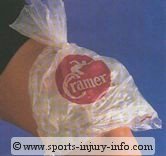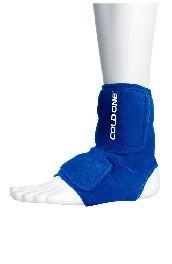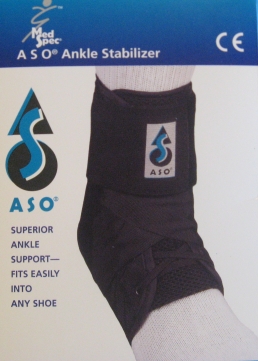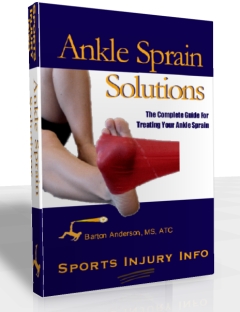Ankle Sprain Treatment

Ankle sprains are one of the most common injuries to occur in sports. Understanding ankle sprain treatment is important no matter what sport you participate in.
Often,
the treatment given within the first 24
hours can speed your return to play by days or even weeks.
Previously,
we talked about ankle sprains in
general, and what to
expect from a common ankle sprain.
Initial ankle sprain treatment consists of the basic R.I.C.E.
principles. Below you will find the specific application of
these principles for ankle sprains.
Controlling Swelling
The most important part of ankle sprain treatment is controlling the
swelling. Many people will tell you that ice is the most important
aspect of treatment. While ice is an important part of the overall
treatment, compression is the key to controlling swelling. Compression
following an ankle sprain can help to control swelling, and can in turn
reduce your overall rehabilitation time.
As
mentioned earlier, swelling is really
your body's way of preparing an injury for healing. Known as
inflammation, it is necessary...to a certain extent. However, our
bodies have a tendency to produce much more of things than we usually
need. And while an ankle will swell up quickly, usually within an hour
or two of injury, it can takes weeks to remove the swelling after
injury. Excessive swelling causes lots of problems, including pain,
decreased range of motion, decreased strength, and loss of function.
Compressing the area immediately following injury
is the key to reducing the swelling and improving your rehabilitation
time. Compression for ankle sprain treatment is best achieved using an
elastic wrap and a horseshoe pad. The compression wrap and pad should
be worn all the time in the first few days following injury, removed
only when you are icing and showering.
Benefits of Ice
In addition to compression, you should ice your ankle several times a
day. This is an important part of ankle sprain treatment in the first
48-72 hours. Ice has several benefits.  First, it provides an analgesic effect by reducing pain. Ice helps to
reduce the conduction velocity of the nerves in the area that are
transmitting pain signals to your brain. This is why you get a "numb"
feeling after applying ice to an area.
First, it provides an analgesic effect by reducing pain. Ice helps to
reduce the conduction velocity of the nerves in the area that are
transmitting pain signals to your brain. This is why you get a "numb"
feeling after applying ice to an area.
Second, ice helps to reduce the amount of hypoxia,
and secondary tissue death. Hypoxia means a lack of oxygen. When your
body begins the inflammatory process to start healing, there is a
reduced supply of oxygen to the area because of the swelling and
injury. There is also an increased need for oxygen beacuse of the
healing process that is taking place. With a low supply and high
demand, cells begin to die because of the lack of oxygen. Increased
cell death results in more inflammation, again, prolonging the healing
process.
Ice helps to slow the metabolic activity
of the cells, thus reducing their need for oxygen. This results in less
tissue death. Ice can be applied using ice packs, a cold ice soak, or
even using a bag of frozen peas. Applications of 15-20 minutes every
hour is appropriate for the first 24-36 hours. After that, icing
several times a day will continue to have benefits.

Ice and compression together, at the same time, is the best way to treat an ankle initially. The most effective way to achieve this is with an ice compression wrap.
I
highly recommend to all of my patients
with ankle sprains to use an ice compression wrap if at all possible.
They are inexpensive when you think about how much time it can cut off
of your rehab, and those expensive visits to my clinic.
Rest and elevation are the other basic principles in ankle sprain
treatment. Resting your ankle by using crutches and not participating
in strenuous activities gives your body time to begin the healing
process. Limiting your activities that those that don't increase your
pain is a good idea for the first few days following injury.
Elevation helps to keep your swelling from
increasing by allowing fluid to move towards the heart. In an elevated
position, gravity helps to draw fluids towards the heart. Without
elevation, gravity tends to pull swelling towards the toes.
Initial Care
Ankle sprains are often regarded as a minor injury, however they can
have quite an impact on your sports performance. If you suffer an ankle
sprain, remember, the RICE principles. Rest, ice, compression, and
elevation, with compression and ice being the most important.
This
basic ankle sprain treatment can reduce your swelling and pain, and is
vital to your overall rehabilitation. And as with any type of injury,
you should seek medical care from your family physician or certified
athletic trainer. It is especially important to seek medical attention
immediately if you are unable to bear any weight on your ankle, or if
you have severe pain that does not respond to the R.I.C.E. principles.
Long Term Care
While an ankle sprain is very painful in the first 2-3 days, pain and
swelling often subside within a week. After your swelling goes down,
you will start to feel better, and probably will want to return to
activities as soon as possible.
However, even
minor ankle sprains
should be treated with rehabilitation. Ankle sprains tend
to have an
additive effect, with each one predisposing you to more frequent and
possibly more serious sprains.
Rehabilitation
exercises to help
strengthen the stabilizing muscles of the ankle, as well as helping to
restore your balance and proprioception are an important part of ankle
sprain treatment even for minor sprains.
Talk with
your family
physician or certified athletic trainer for
more information regarding
rehabilitation after an ankle sprain.
A Complete Program for Ankle Pain
For a complete program to treat your ankle sprain and ankle pain, you not only need strengthening, but mobility and balance
exercises as well.
I offer all of these in a comprehensive ankle rehabilitation program called
Ankle Sprain Solutions.
If you are suffering from ankle pain or a sprained ankle, this is the program for you. It will walk you step by step through the BEST exercises
to treat your ankle pain.
Don't underestimate your ankle sprain - it could end up causing more problems than you can imagine.
Ankle Braces

An
ankle brace may be a good idea if
you have suffered from an ankle
sprain. I place my patients in an ankle brace after a sprain for the
first few months after rehab, just to provide a little support.
The
best brace, and the one that I put my own patients in, is the Ankle
Stabilizing Orthosis or ASO.
The price ranges from $25-$35
dollars. This is a pretty good deal, considering we sell these braces
in the clinic for $50. If it helps prevent another sprain, it is well
worth the investment.
Summary
Ankle sprain treatment centers around controlling your swelling, resting, and then exercises or rehab to restore your strength and balance. An ankle brace is a good idea for returning to sports activities to help provide additional support, and to help prevent re-injury.
Didn't find what you were looking for? Search SII for more information...Running Pain Solutions
Written for Runners by a runner, you'll learn a holistic approach to improving mobility, restoring normal movement and muscle activation patterns, and restoring the body and mind connection.
This Kindle Book contains a step by step program to keep you running pain free. Included are detailed instructions and illustrations for exercises to improve mobility, balance, neuromuscular control, strength and endurance. Only $7.49!
Get Your Copy Today!










